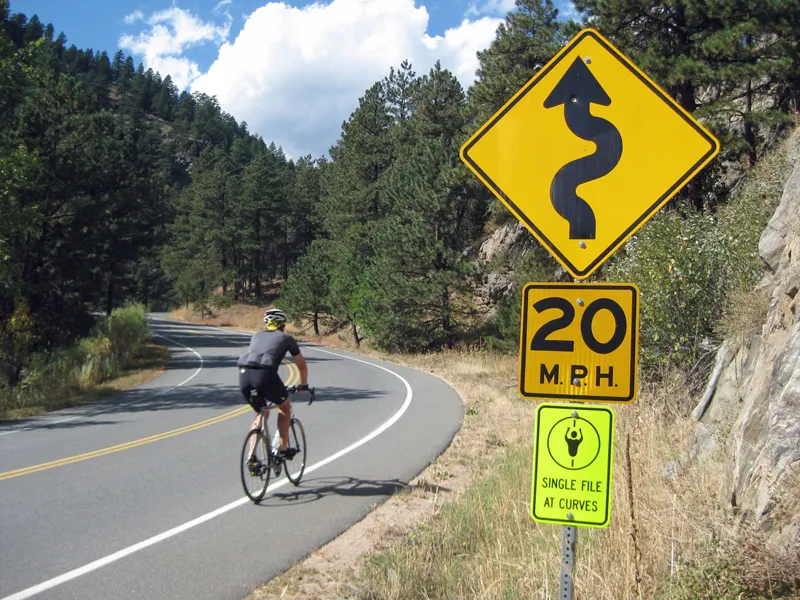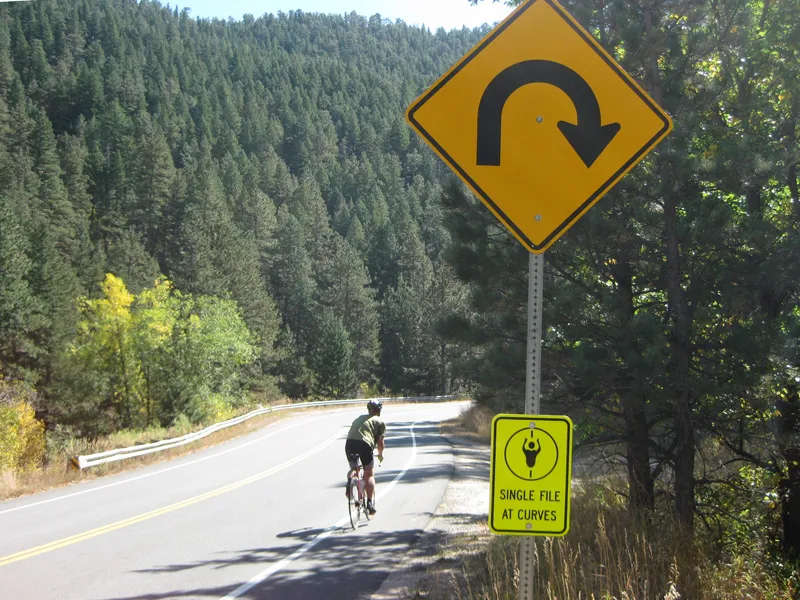New signs put up on the twisting canyon roads of Boulder, Colorado in a bid to reduce tensions between bicycle riders and motorists are both confusing and ill thought through, according to local cyclists.
The signs, which read "Single File At Curves", were put up after drivers complained that a new state law passed in the summer of 2009 was making it impossible for them to overtake bikes.
The legislation required cars to give bikes 3ft of space on the left when passing, and allowed motorists to cross double yellow lines in order to do this. However, drivers said the mountain roads were so narrow and windy that it was difficult to give the required 3ft and still get by safely.
In the fall of 2009, Boulder County sought to address their concerns by forming the Mountain Canyon Cyclist-Driver Working Group which held a series of meetings, attended by both cyclists and drivers. A number of solutions were proposed. One suggestion was a voluntary attempt by cyclists to ride single file while going through turns on Boulder's mountain roads. Officials started looking into developing appropriate signs.
"There were many designs and sign suggestions, and a program of signage that was being developed by a subcommittee," said George Gerstle, head of Boulder County's Department of Transportation. The recommendations of that subcommittee were inconsistent with the signage requirements we're required to follow under state law. The signs that have been placed were recommended by the entire work group."
However, the signs don't make it clear that the single file advice is a voluntary guideline, not mandatory. Many riders have found the wording confusing and wonder if there is a new law requiring them to ride single file in turns.
"I've heard that concern," said Gerstle. "However, responses I've received from both canyon residents and bicyclists have been almost completely positive. The sign are advisory (black on yellow diamond) and placed where there are sharp blind curves, and serve as a reminder to bicyclists that single file riding in these locations is advised for safety reasons."
The problem is that the signs aren't yellow-and-black and they aren't diamond-shaped. "I think the signs are very confusing and are likely to be interpreted by cyclists and motorists as being a law, even though riding side-by-side is completely legal in the state of Colorado and on those canyon roads," said Dan Grunig, executive director of Bicycle Colorado, the state's leading cycling-related advocacy group.
"The biggest concern we have is the circumstance where two cyclists are riding side-by-side and they are within the law to be doing that and one or both of them is hit from behind. Even though they were doing nothing illegal, these signs add liability in a potential jury case. An opposing lawyer can say, 'look, even the county says they should be riding single file, therefore it's not my client's fault for hitting them."
Moreover, Grunig says that one critical point appears to have been overlooked: even with cyclists riding single file in the turns, it isn't possible for a car to legally pass them. "The lanes are only 11-12ft wide," he said. "A cyclist needs to give a couple of feet to the right of the fog line [edge of the road] and the width of the cyclist from elbow to elbow is about 2ft, so there's 4-5ft right there. Most vehicles are 7-8ft wide and with a 3ft passing distance it doesn't add up. You can't all fit into one lane."
Which begs the question, 'what problem were these signs trying to address in the first place?'


